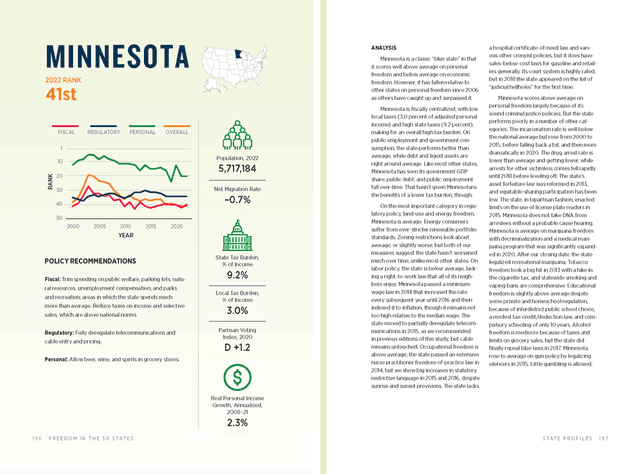Policy Recommendations
- Fiscal Trim spending on public welfare, parking lots, natural resources, unemployment compensation, and parks and recreation, areas in which the state spends much more than average. Reduce taxes on income and selective sales, which are above national norms.
- Regulatory Fully deregulate telecommunications and cable entry and pricing.
- Personal Allow beer, wine, and spirits in grocery stores.
Analysis
Minnesota is a classic “blue state” in that it scores well above average on personal freedom and below average on economic freedom. However, it has fallen relative to other states on personal freedom since 2006 as others have caught up and surpassed it.
Minnesota is fiscally centralized, with low local taxes (3.0 percent of adjusted personal income) and high state taxes (9.2 percent), making for an overall high tax burden. On public employment and government consumption, the state performs better than average, while debt and liquid assets are right around average. Like most other states, Minnesota has seen its government GDP share, public debt, and public employment fall over time. That hasn’t given Minnesotans the benefits of a lower tax burden, though.
On the most important category in regulatory policy, land-use and energy freedom, Minnesota is average. Energy consumers suffer from ever-stricter renewable portfolio standards. Zoning restrictions look about average, or slightly worse, but both of our measures suggest the state hasn’t worsened much over time, unlike most other states. On labor policy, the state is below average, lacking a right-to-work law that all of its neighbors enjoy. Minnesota passed a minimum-wage law in 2014 that increased the rate every subsequent year until 2016 and then indexed it to inflation, though it remains not too high relative to the median wage. The state moved to partially deregulate telecommunications in 2015, as we recommended in previous editions of this study, but cable remains untouched. Occupational freedom is above average; the state passed an extensive nurse practitioner freedom-of-practice law in 2014, but we show big increases in statutory restrictive language in 2015 and 2016, despite sunrise and sunset provisions. The state lacks a hospital certificate-of-need law and various other cronyist policies, but it does have sales-below-cost laws for gasoline and retailers generally. Its court system is highly rated, but in 2018 the state appeared on the list of “judicial hellholes” for the first time.
Minnesota scores above average on personal freedom largely because of its sound criminal justice policies. But the state performs poorly in a number of other categories. The incarceration rate is well below the national average but rose from 2000 to 2015, before falling back a bit, and then more dramatically in 2020. The drug arrest rate is lower than average and getting lower, while arrests for other victimless crimes fell rapidly until 2018 before leveling off. The state’s asset forfeiture law was reformed in 2013, and equitable-sharing participation has been low. The state, in bipartisan fashion, enacted limits on the use of license plate readers in 2015. Minnesota does not take DNA from arrestees without a probable cause hearing. Minnesota is average on marijuana freedom with decriminalization and a medical marijuana program that was significantly expanded in 2020. After our closing date, the state legalized recreational marijuana. Tobacco freedom took a big hit in 2013 with a hike in the cigarette tax, and statewide smoking and vaping bans are comprehensive. Educational freedom is slightly above average despite some private and homeschool regulation, because of interdistrict public school choice, a modest tax-credit/deduction law, and compulsory schooling of only 10 years. Alcohol freedom is mediocre because of taxes and limits on grocery sales, but the state did finally repeal blue laws in 2017. Minnesota rose to average on gun policy by legalizing silencers in 2015. Little gambling is allowed.

